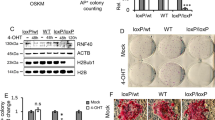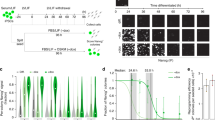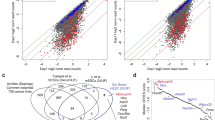Abstract
The induction of pluripotent stem cells (iPSCs) by defined factors is poorly understood stepwise. Here, we show that histone H3 lysine 9 (H3K9) methylation is the primary epigenetic determinant for the intermediate pre-iPSC state, and its removal leads to fully reprogrammed iPSCs. We generated a panel of stable pre-iPSCs that exhibit pluripotent properties but do not activate the core pluripotency network, although they remain sensitive to vitamin C for conversion into iPSCs. Bone morphogenetic proteins (BMPs) were subsequently identified in serum as critical signaling molecules in arresting reprogramming at the pre-iPSC state. Mechanistically, we identified H3K9 methyltransferases as downstream targets of BMPs and showed that they function with their corresponding demethylases as the on/off switch for the pre-iPSC fate by regulating H3K9 methylation status at the core pluripotency loci. Our results not only establish pre-iPSCs as an epigenetically stable signpost along the reprogramming road map, but they also provide mechanistic insights into the epigenetic reprogramming of cell fate.
This is a preview of subscription content, access via your institution
Access options
Subscribe to this journal
Receive 12 print issues and online access
$209.00 per year
only $17.42 per issue
Buy this article
- Purchase on Springer Link
- Instant access to full article PDF
Prices may be subject to local taxes which are calculated during checkout







Similar content being viewed by others
References
Takahashi, K. et al. Induction of pluripotent stem cells from adult human fibroblasts by defined factors. Cell 131, 861–872 (2007).
Takahashi, K. & Yamanaka, S. Induction of pluripotent stem cells from mouse embryonic and adult fibroblast cultures by defined factors. Cell 126, 663–676 (2006).
Yamanaka, S. & Blau, H.M. Nuclear reprogramming to a pluripotent state by three approaches. Nature 465, 704–712 (2010).
Hussein, S.M. et al. Copy number variation and selection during reprogramming to pluripotency. Nature 471, 58–62 (2011).
Bar-Nur, O., Russ, H.A., Efrat, S. & Benvenisty, N. Epigenetic memory and preferential lineage-specific differentiation in induced pluripotent stem cells derived from human pancreatic islet β cells. Cell Stem Cell 9, 17–23 (2011).
Plath, K. & Lowry, W.E. Progress in understanding reprogramming to the induced pluripotent state. Nat. Rev. Genet. 12, 253–265 (2011).
Mikkelsen, T.S. et al. Dissecting direct reprogramming through integrative genomic analysis. Nature 454, 49–55 (2008).
Sridharan, R. et al. Role of the murine reprogramming factors in the induction of pluripotency. Cell 136, 364–377 (2009).
Ang, Y.S. et al. Wdr5 mediates self-renewal and reprogramming via the embryonic stem cell core transcriptional network. Cell 145, 183–197 (2011).
Singhal, N. et al. Chromatin-remodeling components of the BAF complex facilitate reprogramming. Cell 141, 943–955 (2010).
Onder, T.T. et al. Chromatin-modifying enzymes as modulators of reprogramming. Nature 483, 598–602 (2012).
Li, R. et al. A mesenchymal-to-epithelial transition initiates and is required for the nuclear reprogramming of mouse fibroblasts. Cell Stem Cell 7, 51–63 (2010).
Samavarchi-Tehrani, P. et al. Functional genomics reveals a BMP-driven mesenchymal-to-epithelial transition in the initiation of somatic cell reprogramming. Cell Stem Cell 7, 64–77 (2010).
Silva, J. et al. Promotion of reprogramming to ground state pluripotency by signal inhibition. PLoS Biol. 6, e253 (2008).
Mattout, A., Biran, A. & Meshorer, E. Global epigenetic changes during somatic cell reprogramming to iPS cells. J. Mol. Cell Biol. 3, 341–350 (2011).
Stadtfeld, M. et al. Aberrant silencing of imprinted genes on chromosome 12qF1 in mouse induced pluripotent stem cells. Nature 465, 175–181 (2010).
Stadtfeld, M. et al. Ascorbic acid prevents loss of Dlk1-Dio3 imprinting and facilitates generation of all–iPS cell mice from terminally differentiated B cells. Nat. Genet. 44, 398–405 (2012).
Chen, J. et al. Towards an optimized culture medium for the generation of mouse induced pluripotent stem cells. J. Biol. Chem. 285, 31066–31072 (2010).
Esteban, M.A. et al. Vitamin C enhances the generation of mouse and human induced pluripotent stem cells. Cell Stem Cell 6, 71–79 (2010).
Wang, T. et al. The histone demethylases Jhdm1a/1b enhance somatic cell reprogramming in a vitamin-C–dependent manner. Cell Stem Cell 9, 575–587 (2011).
Hanna, J.H., Saha, K. & Jaenisch, R. Pluripotency and cellular reprogramming: facts, hypotheses, unresolved issues. Cell 143, 508–525 (2010).
Ichida, J.K. et al. A small-molecule inhibitor of Tgf-β signaling replaces Sox2 in reprogramming by inducing Nanog. Cell Stem Cell 5, 491–503 (2009).
Herrera, B. & Inman, G.J. A rapid and sensitive bioassay for the simultaneous measurement of multiple bone morphogenetic proteins. Identification and quantification of BMP4, BMP6 and BMP9 in bovine and human serum. BMC Cell Biol. 10, 20 (2009).
David, L. et al. Bone morphogenetic protein-9 is a circulating vascular quiescence factor. Circ. Res. 102, 914–922 (2008).
Wang, W. et al. Rapid and efficient reprogramming of somatic cells to induced pluripotent stem cells by retinoic acid receptor γ and liver receptor homolog 1. Proc. Natl. Acad. Sci. USA 108, 18283–18288 (2011).
Feng, B. et al. Reprogramming of fibroblasts into induced pluripotent stem cells with orphan nuclear receptor Esrrb. Nat. Cell Biol. 11, 197–203 (2009).
Fritsch, L. et al. A subset of the histone H3 lysine 9 methyltransferases Suv39h1, G9a, GLP, and SETDB1 participate in a multimeric complex. Mol. Cell 37, 46–56 (2010).
Frontelo, P. et al. Suv39h histone methyltransferases interact with Smads and cooperate in BMP-induced repression. Oncogene 23, 5242–5251 (2004).
Krishnan, S., Horowitz, S. & Trievel, R.C. Structure and function of histone H3 lysine 9 methyltransferases and demethylases. Chembiochem 12, 254–263 (2011).
Loh, Y.H., Zhang, W., Chen, X., George, J. & Ng, H.H. Jmjd1a and Jmjd2c histone H3 Lys 9 demethylases regulate self-renewal in embryonic stem cells. Genes Dev. 21, 2545–2557 (2007).
Hanna, J. et al. Direct cell reprogramming is a stochastic process amenable to acceleration. Nature 462, 595–601 (2009).
Koche, R.P. et al. Reprogramming factor expression initiates widespread targeted chromatin remodeling. Cell Stem Cell 8, 96–105 (2011).
Shi, Y. et al. Induction of pluripotent stem cells from mouse embryonic fibroblasts by Oct4 and Klf4 with small-molecule compounds. Cell Stem Cell 3, 568–574 (2008).
Lachner, M., O'Carroll, D., Rea, S., Mechtler, K. & Jenuwein, T. Methylation of histone H3 lysine 9 creates a binding site for HP1 proteins. Nature 410, 116–120 (2001).
Lu, C. et al. IDH mutation impairs histone demethylation and results in a block to cell differentiation. Nature 483, 474–478 (2012).
Oberdoerffer, P. & Sinclair, D.A. The role of nuclear architecture in genomic instability and ageing. Nat. Rev. Mol. Cell Biol. 8, 692–702 (2007).
Chen, J. et al. BMPs functionally replace Klf4 and support efficient reprogramming of mouse fibroblasts by Oct4 alone. Cell Res. 21, 205–212 (2011).
Childs, A.J. et al. BMP signaling in the human fetal ovary is developmentally regulated and promotes primordial germ cell apoptosis. Stem Cells 28, 1368–1378 (2010).
Huang, W., Sherman, B.T. & Lempicki, R.A. Systematic and integrative analysis of large gene lists using DAVID bioinformatics resources. Nat. Protoc. 4, 44–57 (2009).
Acknowledgements
We are grateful to X. Shu for careful reading and critical comments of the manuscript. We appreciate the contributions of J. Nie to microarray data analysis. We thank H. Zheng, X. Liu, J. Zhao, H. Wu, F. Li, D. Qin, R. Li, M. Esteban, G. Xu and B. Qin for constructive criticism. We also thank L. Zeng, G. Zhu, S. Sun, Y. Wu, K. Lai, H. Pang, H. Zhang, W. He, A. Jiang, T. Zhou, J. Li, S. Huang, J. Xu and D. Yang for technical assistance. We deeply appreciate the assistance of H. Song, K. Mo and S. Chu in blastocyst injection. This work is supported in part by the Strategic Priority Research Program of the Chinese Academy of Sciences (grants XDA01020401, XDA01020202 and XDA01020302), the National Basic Research Program of China (grants 2009CB941102, 2011CBA01106, 2011CB965204 and 2012CB966802), the National Natural Science Foundation of China (grants 31271357 and 91213304), the Ministry of Science and Technology International Technology Cooperation Program (grants 2010DFB30430 and 2012DFH30050), the National Science and Technology Major Special Project on Major New Drug Innovation (grant 2011ZX09102-010), the Bureau of Science and Technology of Guangzhou Municipality, China (grant 2010U1-E00521), the Guangdong Science and Technology Project (grants 2010A090603001 and 2011A08030002), Science and Technology Planning Project of Guangdong Province, China (grant 2011A060901019), the One Hundred Person Project of The Chinese Academy of Sciences to D.P., the Youth Innovation Promotion Association of the Chinese Academy of Sciences and the Pearl River Nova program (grant 2012J2200070). We wish to thank all members of our laboratories for their support.
Author information
Authors and Affiliations
Contributions
Jiekai Chen initiated the study, designed and performed the experiments, analyzed the data and wrote the manuscript. H. Liu performed the experiments and analyzed the data. J.L., Jing Chen and L.G. performed reprogramming experiments. J.Q., J.Y. and Y.W. constructed plasmids and performed experiments on histone modification. B.W., T.P., Y.Z. and D.L. performed coimmunoprecipitation experiments. J.Y. performed qPCR analyses and chromatin immunoprecipitation experiments. H. Liang constructed plasmids and analyzed Smad phosphorylation. Y.C. derived iX pre-iPSCs and screened small molecule compounds on pre-iPSCs. J.Y., Jing Chen, J.Z. and X.L. identified the pre-iPSCs and iPSCs. X.Z. performed blastocyst injection. S.C. isolated hepatocytes. T.W. cloned histone demethylases. D.P. conceived and supervised the whole study and wrote the manuscript.
Corresponding author
Ethics declarations
Competing interests
The authors declare no competing financial interests.
Supplementary information
Supplementary Text and Figures
Supplementary Figures 1–8 and Supplementary Tables 1 and 3–7 (PDF 4839 kb)
Supplementary Table 2
481 overlap genes (XLS 96 kb)
Rights and permissions
About this article
Cite this article
Chen, J., Liu, H., Liu, J. et al. H3K9 methylation is a barrier during somatic cell reprogramming into iPSCs. Nat Genet 45, 34–42 (2013). https://doi.org/10.1038/ng.2491
Received:
Accepted:
Published:
Issue Date:
DOI: https://doi.org/10.1038/ng.2491
This article is cited by
-
Genome-wide ATAC-see screening identifies TFDP1 as a modulator of global chromatin accessibility
Nature Genetics (2024)
-
Epigenetic OCT4 regulatory network: stochastic analysis of cellular reprogramming
npj Systems Biology and Applications (2024)
-
Unraveling the 2,3-diketo-l-gulonic acid-dependent and -independent impacts of l-ascorbic acid on somatic cell reprogramming
Cell & Bioscience (2023)
-
H3K36 methylation maintains cell identity by regulating opposing lineage programmes
Nature Cell Biology (2023)
-
Mechanisms, pathways and strategies for rejuvenation through epigenetic reprogramming
Nature Aging (2023)



